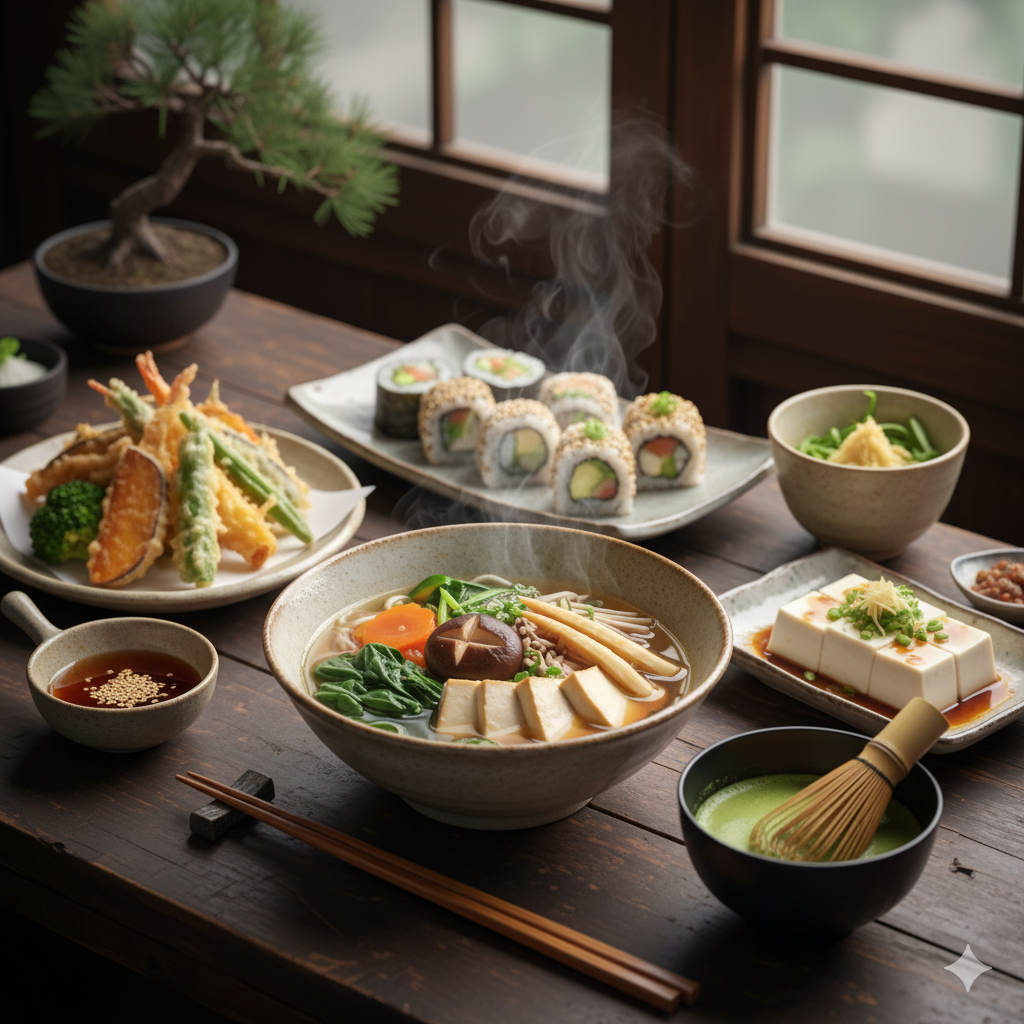Vegetarian Japanese Dishes That Even Meat Lovers End Up Loving

Japanese cuisine is world-famous for its balance, flavor, and presentation. But for many travelers, the idea of eating vegetarian in Japan can sound challenging. After all, the country is known for its love of sushi, grilled meats, and ramen made with rich pork broth. Yet, Japan has a long tradition of plant-based dishes that are not only delicious but also deeply satisfying, even for devoted carnivores. From Buddhist temple meals to modern café creations, these vegetarian Japanese dishes prove that flavor doesn’t depend on meat.
The Roots of Vegetarianism in Japan
Before meat became common in Japanese cuisine, the country had centuries of vegetarian tradition. This was largely due to Buddhism, which encouraged a plant-based diet. Monks developed a cooking style called shōjin ryōri, a refined form of temple cuisine focused on vegetables, tofu, and seasonal ingredients. The goal wasn’t just nourishment but mindfulness, simplicity, and appreciation for nature’s flavors. While modern Japan has embraced meat and fish, the essence of shōjin ryōri continues to inspire countless dishes found in homes, restaurants, and even convenience stores.
Tofu: Japan’s Most Versatile Protein
If there’s one ingredient that defines Japanese vegetarian cuisine, it’s tofu. Far from being bland, Japanese tofu comes in endless varieties and textures such as silken, firm, grilled, or fried. Dishes like agedashi tofu, where deep-fried tofu is served in a warm soy-based broth, or yudofu, a simple hot tofu dish from Kyoto, showcase the ingredient’s delicate flavor and comforting warmth. Even meat eaters are often surprised at how satisfying these dishes can be.
Vegetable Tempura: Crispy, Light, and Addictive
Tempura is one of Japan’s most famous foods, and it doesn’t need meat or seafood to shine. Perfectly crisp, light, and never greasy, vegetable tempura features seasonal vegetables like sweet potato, pumpkin, mushrooms, eggplant, and shiso leaves coated in a delicate batter and fried to perfection. Served with dipping sauce or over a bowl of rice, it’s an instant favorite even among those who usually crave meat.
Vegetarian Ramen: Comfort Without the Pork
Ramen is often thought of as a meat lover’s dish, but Japan’s vegetarian ramen scene has grown rapidly in recent years. Instead of pork or chicken broth, chefs use miso, soy milk, mushrooms, or kombu (kelp) to build rich, umami-packed bases. Toppings like tofu, bamboo shoots, roasted corn, and soft-boiled eggs create a deeply satisfying bowl. In cities like Tokyo, Kyoto, and Osaka, vegetarian ramen shops have become must-visit spots for both locals and tourists.
Onigiri and Inari Sushi: Simple Yet Flavorful
Not all Japanese comfort food involves fish or meat. Onigiri, rice balls wrapped in seaweed, often come with vegetarian fillings like umeboshi (pickled plum) or kombu seaweed. Meanwhile, inari sushi, made with rice stuffed inside sweet fried tofu pockets, is a snack so delicious that even meat lovers can’t resist grabbing more than one. These are easy to find in convenience stores and make perfect quick meals on the go.
Miso Soup and Tsukemono: The Everyday Staples
No Japanese meal feels complete without a bowl of miso soup. Made from fermented soybean paste, this soup can be completely vegetarian when made with kombu-based stock instead of fish. Paired with tsukemono, Japan’s colorful pickled vegetables, it offers a perfect balance of salty, sour, and umami flavors that refresh the palate and complement any dish.
Shojin Ryori: The Ultimate Plant-Based Experience
For travelers seeking the purest vegetarian experience, trying shōjin ryōri is a must. Usually served in Buddhist temples or specialty restaurants, it’s a beautifully arranged multi-course meal that highlights harmony and seasonality. Expect dishes like simmered vegetables, sesame tofu, pickles, and rice, each carefully prepared to bring out natural flavors without relying on meat, fish, or even garlic and onions. It’s more than a meal—it’s a glimpse into Japan’s spiritual and culinary heritage.
The Modern Vegetarian Wave
As global interest in plant-based eating grows, Japan has started embracing vegetarian and vegan trends in new ways. Cafés in Tokyo and Kyoto now serve plant-based katsu sandwiches, soy-based karaage, and even vegan sushi made with marinated vegetables or konjac “fish.” What’s exciting is how Japan’s attention to detail transforms these dishes into experiences that satisfy both the body and the eyes.
Final Thoughts
Japan might be famous for sushi and wagyu beef, but its vegetarian side is equally rich and rewarding. From delicate tofu dishes to hearty ramen and crispy tempura, Japanese vegetarian cuisine offers comfort, beauty, and flavor that anyone can appreciate. For meat lovers, these dishes often become unexpected favorites, proving that great food doesn’t depend on meat but on skill, balance, and heart.



